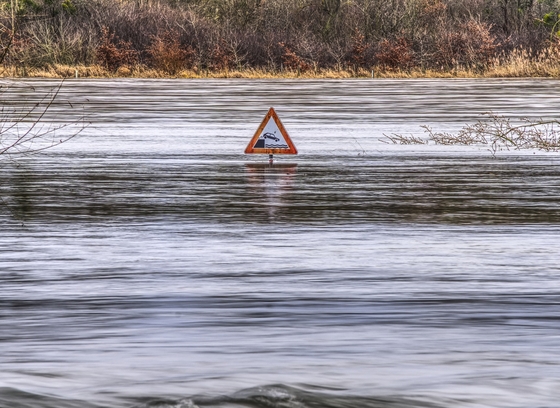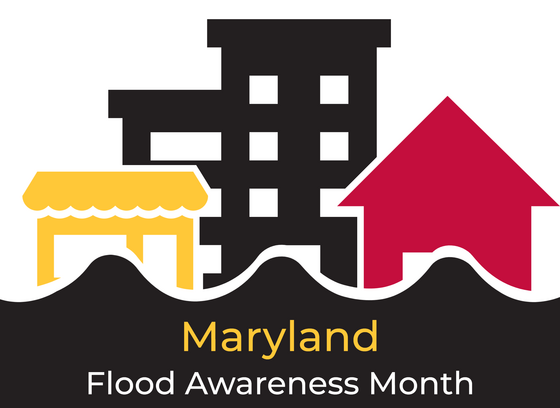About
Flood protection activities such as maintaining floodplain information, capital improvement programs, and drainage improvement projects help save lives and property when a flood occurs. Read more to learn about Howard County’s flood protection activities.

April is Maryland Flood Awareness Month!
Flooding is the number one natural hazard in Maryland. Therefore, April is designated Flood Awareness Month in Maryland so that local, state, federal, academic, business, and non-profit partners can share information and tools that will allow you to:
KNOW - Know your flood risk at home, work, etc.
PLAN - Develop a plan for reducing your risk
ACT - Take action!
Contact the Howard County Stormwater Management Division at DoIFlood@HowardCountyMD.gov or by calling 410-313-6444 to find out more about your flood risk. Follow #FloodAwareMD on your favorite social media platforms for flood awareness tips throughout the month of April. And click on the link below to learn more about Maryland Flood Awareness Month from the Maryland Resiliency Partnership.

Floodplains are low land areas that are located next to rivers, streams, and lakes. Floodplains provide natural filtration of pollutants and provide breeding and feeding areas for wildlife. During increased rain and snow activity, floodplains store rainwater, melted snowfall, and reduce flooding in surrounding areas. It is important to allow the floodplain to carry and store floodwaters in order to protect human life and property from flood damage, and this is why Howard County does not allow building in the floodplain.
Dumping into our floodplains via the streams and rivers is a violation of Howard County Code Section 18.205 - Obstruction, Damage and Drainage and Section 18.502 - Prohibited Discharges and Illicit Connections. Even grass clippings and branches that are dumped in the streams can accumulate and block the channels.
When you expect a heavy rain or snow event, check that your local storm drains are clear of debris including accumulations of leaves. This will prevent water from backing up causing localized flooding. If you notice that storm drains and inlets need to be cleaned out, please contact the Bureau of Highways at 410-313-7450.
In Howard County, there are scattered areas that occasionally flood. They include, but are not limited to Main Street, Elkridge, and Allview Estates. Click on the link for Frequently Flooded Roads for roads that frequently flood in Howard County.
Howard County provides flood safety and property protection information in the form of booklets and brochures, which can be obtained by calling the Bureau of Environmental Services at 410-313-6444. Here are a few things to watch out for:
- If you live in an area subject to flooding, secure your property and be prepared for evacuation.
- Do not walk through flowing water. Drowning is the number one cause of flood deaths, mostly from flash floods. Currents can be deceptive, and 6 inches of moving water can knock you off your feet. If you walk in standing water, use a pole or stick.
- Look before you step. After a flood, the ground and floor are covered with debris including broken bottles and nails. Floors and stairs that are covered with mud can be very slippery.
- Do not drive through a flooded area. More drowning deaths occur in cars than anywhere else during a flood.
- Don't drive around road barriers; the road or bridge may be washed out.
- Stay away from power lines and electrical wires. The number two flood killer after drowning is
electrocution. Electrical currents can travel through water. Some appliances, such as television sets,
keep electrical charges even after they have been unplugged. Don't use appliances or motors that have
gotten wet unless they have been taken apart, cleaned, and dried. - As water levels rise due to rain and ground saturation, flooding of basements and lower levels of
homes and businesses is possible. Water can threaten utilities or the structural integrity of the home
or building. - Be alert for gas leaks. Use a flashlight to inspect for damage. Don't smoke or use candles, lanterns, or
open flames unless you know the gas has been turned off and the area has been ventilated. - Floodwaters can take hours or days to rise and fall and can present a hazardous situation.
In Howard County, flood origins consist of riverine flooding from the tributaries of the Patuxent River bordering Prince George’s and Montgomery Counties to the southwest and the Patapsco River bordering Carroll and Baltimore County to the north and northeast. The rivers include the Little Patuxent River, the Middle Patuxent River, Cattail Creek, Deep Run, Dorsey Run, Bonnie Branch, Plumtree Branch, Guilford Branch, Hammond Branch, Clyde’s Branch, Tiber-Hudson Branch, and many others.
Howard County has had numerous incidents of flooding, including major events such as Tropical Storm Agnes in 1972, Hurricane Eloise in 1975, Hurricane Floyd in 1999, and Tropical Storm Lee in 2011. More recently, the Ellicott City area experienced major flooding during rain events on July 30, 2016 and May 27, 2018. Most incidents are the result of tropical systems, nor’easters, and flash flooding from sudden, short-lived rainstorms. In 2010 and updated in 2018, Howard County developed a Flood Mitigation Plan (FMP) that outlines these flooding risks, preventative measures, and mitigation goals.
During an emergency, the County's Public Information Office (PIO) sends out announcements to all television and radio stations that service the County, including WBAL and other local TV and radio stations. These announcements are then broadcast to residents. The County also has a Facebook page and Twitter account that residents can visit to get updates on emergency situations. For example, in September of every year, the County offers tips on how to prepare for emergencies during National Preparedness Month.
The County also maintains a local flood warning system. This system consists of several rain and stream level gauges located strategically throughout the County. The gauges measure the "stage" or the elevation of the water surface. The gauges are monitored during storms to determine whether significant flooding can be expected.
Residents should consider buying a National Oceanic and Atmospheric Administration (NOAA) weather radio that broadcasts continuous weather information on a frequency that is not heard on a regular radio. The NOAA radio can provide weather updates and keep you informed of weather hazards.
For more information on how you can be prepared, please visit ReadyHoCo.com. There you will find preparedness tips for your home and business as well as information about all the hazards that impact Howard County.
Floods and the damage they create can happen very quickly. It’s important to be prepared and have a plan beforehand that all members of your family will be familiar with and follow. Visit Ready.gov for guidelines on how to plan for an emergency.
In addition, a “Grab and Go” kit is an important part of how you respond to an emergency. You may want to keep one in your car and one in your home so that you’ll always have basic supplies with you when an emergency strikes. Visit Ready.gov for more information on what to put in a “Grab and Go” kit.
There are things you can do to minimize or eliminate property damage before a flood event. Properly grading your property, elevating and securing electrical appliances, using flood-resistant materials on exterior surfaces, and elevating or covering furniture and valuables are just a few ways to protect your property.
Buildings can also be permanently protected through “retrofitting”, which involves making changes to an
existing building to protect it from flooding.
There are six common retrofitting methods:
- Elevation - elevating the entire house so that the lowest floor is above the flood level
- Wet Floodproofing - making uninhabitable portions of your house resistant to flood damage and allowing
water to enter during flooding - Relocation - moving your house out of the floodplain to higher ground
- Dry Floodproofing - sealing your home to prevent flood waters from entering
- Levees and Floodwalls - building a floodwall or levee around your home to hold back flood waters
- Demolition - tearing down your damaged home and either rebuilding properly on the same property or buying or building a house elsewhere. You can also add a second story to the building and use the bottom story for parking, access, and storage.
In an emergency, sandbags can be used to protect your property against flooding. For more information on
floodproofng your home, order the Homeowner’s Guide to Retrofitting, Publication 312, by calling FEMA at
1-800-480-2520.
High winds from hurricanes and storms can turn unsecured objects around your home into projectiles that can cause substantial damage. Garbage cans, sheds, garden furniture and other structures should be securely anchored with straps or ground anchors or if possible, placed indoors during high wind events. Anticipate tree damage by properly maintaining and trimming dead or dying trees.
Substantial Improvement
If a pre-FIRM building is remodeled, renovated, or improved and the project cost is 50% or more of the building value, the building will have to be brought into compliance with the NFIP standards. Project costs include structural costs, finished materials, built-in appliances, flooring, and interior finishes. The cost of permitting is not included.
Substantial Damage
If a building, which is located in a special hazard flood area, is damaged by any cause and the repair cost is 50% or more of the value of the building, the 50% Rule or Substantial Damage Rule applies, and the building must be must be elevated and brought into compliance. The damage can be the result of wind, flood, fire, earthquake, or man. This 50% Rule regulation applies to all structures in the designated special flood hazard area [100-Year Floodplain]. When evaluating a structure’s damage, only the building value, or market value, of the structure is considered, while the underlying land and exterior improvements are excluded.